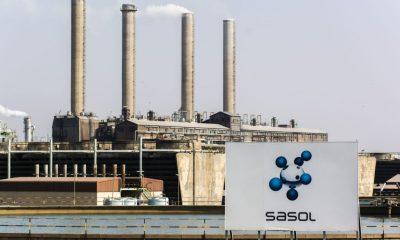Business
Sasol Earnings Plunge 48% Amid Lower Oil Prices and Refinery Impairments

South African petrochemical giant Sasol has reported a massive 48% decline in earnings for the first half of the financial year ending December 2024, reflecting weaker global oil prices, refinery impairments, and lower fuel margins.
The company’s revenue fell 10% to R122.1 billion, mainly due to a 13% drop in Brent crude oil prices and declining refining margins and fuel price differentials.
Adding to the pressure, sales volumes fell by 5%, driven by lower production and weaker market demand.
Sasol’s Earnings Breakdown: The Key Numbers
Earnings: R4.75 billion (down 48% from R9.18 billion).
Basic EPS: R7.22 (down 52%).
Headline EPS: R14.13 (down 31%).
Free cash flow: -R1.1 billion (deficit).
Net debt: US$4.3 billion (above the US$4 billion trigger for dividends).
Due to the negative cash flow and high debt levels, Sasol has not declared an interim dividend.
“This exceeds the net debt trigger, therefore no interim dividend was declared,” the company stated.
Why Are Sasol’s Earnings Dropping?
The biggest contributors to Sasol’s financial downturn include:
Lower Brent crude oil prices (-13% YoY).
Weak refining margins and product differentials.
A stronger rand exchange rate, impacting revenue.
Lower fuel production and higher feedstock costs.
Full impairments of the Secunda and Sasolburg refineries, hitting the balance sheet.
Performance by Business Segment
Mining: Earnings more than doubled to R2.3 billion, thanks to a better coal pricing agreement with Secunda Operations. However, this was offset by lower export coal prices and internal sales.
Gas Production: Earnings jumped 65% to R3.9 billion, driven by higher gas prices and lower costs.
Chemicals:
- Africa: Sales rose 1%.
- Americas & Eurasia: Both regions saw declining sales, with Eurasia recording a R100 million loss.
Fuels (Biggest Drag on Earnings):
The fuels segment lost R1 billion, affected by:
Weaker oil prices.
Declining refining margins.
Lower production output.
Higher operating costs.
What’s Next for Sasol?
With its debt above the US$4 billion threshold and free cash flow in negative territory, Sasol is focusing on cost reductions and operational efficiencies to stabilize earnings.
However, the company remains highly sensitive to global oil prices and exchange rate fluctuations, meaning further earnings volatility could be expected.
Will Sasol Recover?
Sasol’s first-half results for FY2024 highlight significant challenges, but improving global oil prices and cost-cutting efforts could support a gradual recovery.
However, with no dividend payout and ongoing operational struggles, investors will be watching closely to see if Sasol can turn things around in the second half of the year.
Follow Joburg ETC on Facebook, Twitter , TikTok and Instagram
For more News in Johannesburg, visit joburgetc.com





















